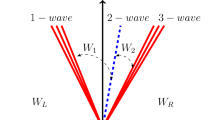Abstract
Certain modifications of three-equation turbulence models are proposed. They are intended for increasing the accuracy of the calculations of turbulent flows in nozzles with boundary layer separation and in supersonic jets with complicated shock wave structures. Basing on the idea of the inclusion of flow prehistory in terms of an additional relaxation equation for nonequilibrium turbulent viscosity we propose three modifications of the k-ω-µ t model based on the k-ω model and a version of the k- ɛ-µ t turbulence model. In these modifications we introduce an additional dependence of the nonequilibrium turbulent viscosity relaxation time on different physical parameters which can be important near the point of boundary layer separation from the nozzle wall, such as viscous effects and effects of large gradients of the mean velocity and the kinetic energy of turbulence (turbulent pressure). The comparison of the results of the calculations with the experimental data shows that all the proposed versions of the three-equation models make it possible to improve the accuracy of the calculations of turbulent flows in nozzles and jets.
Similar content being viewed by others
References
M.E. Olsen and T.J. Coakley, “The Lag Model, a Turbulence Model for Nonequilibrium Flows,” AIAA Paper No. 2564 (2001).
J.O. Hinze, “Memory Effects in Turbulence,” Zeitschr. Angew. Math. Mech. 56, 403 (1976).
T.A. Reyhner, “Finite Difference Solutions of the Compressible Turbulent Boundary Layer Equations,” in: Proc. Comp. Turbulent Boundary Layers. Stanford Conf. Vol. 1, Stanford Univ. Press (1968), p. 375.
J. Lee, M.L. Sloan, and G.C. Paynter, “Lag Model for Turbulent Boundary Layers over Rough Bleed Surfaces,” J. Propulsion Power 10, 562 (1994).
R.P. Lillard, M.E. Olsen, A.B. Oliver, G.A. Blaidsell, and A.S. Lyrintzis, “The Lag RST Model: a Turbulence Model for Nonequilibrium Flows,” AIAA Paper No. 444 (2012).
A.J. Revell, S. Benhamadouche, T. Craft, and D. Laurence, “A Stress-Strain Lag Eddy Viscosity Model for Unsteady Mean Flow,” Int. J. Heat Fluid Flow, 27, 821 (2006).
G.S. Glushko and I.A. Kryukov, “Effect of the Turbulent Energy Gradient and the Presence of a Wall on the Turbulent Process of Momentum Transport,” Fluid Dynamics 38(4), 561 (2003).
G.S. Glushko and I.A. Kryukov, “Turbulent Transport Coefficients with Allowance for Density Fluctuations,” Fluid Dynamics 36(1), 39 (2001).
Q. Xiao, H.-M. Tsai, and F. Liu, “Computation of Turbulent Separated Nozzle Flow by a Lag Model,” J. Propulsion Power 21, 368 (2005).
D. Wilcox, Turbulence Modeling for CFD, DCW Industries Inc., Ca (1994).
G.S. Glushko, I. É. Ivanov, and I.A. Kryukov, “Numerical Modeling of Separated Flows in Nozzles,” [in Russian], Preprint No. 815, Russian Academy of Sciences, Institute for Problems in Mechanics (2006).
I.A. Kryukov, “Calculation of Supersonic Turbulent Flows,” Vestn. MAI, 16(2), 101 (2009).
G.S. Glushko, I. É. Ivanov, and I.A. Kryukov, “Calculation of Supersonic Turbulent Flows,” [in Russian], Preprint No. 793, Russian Academy of Sciences, Institute for Problems in Mechanics (2006).
I. É. Ivanov and I.A. Kryukov, “Numerical Investigation of Turbulent Flows with Confined and Free Separation in Contoured Nozzles,” Vestn. MAI, 16(7), 23 (2009).
S. Sarkar, G. Erlebacher, M.Y. Hussaini, and H.O. Kreiss, “The Analysis and Modelling of Dilatational Terms in Compressible Turbulence,” J. Fluid Mech 227, 473 (1991).
I. É. Ivanov and I.A. Kryukov, “Quasimonotonic Higher-Order Method for Calculating Internal and Jet Inviscid-Gas Flows,” Mat. Model. 8(6), 47 (1996).
G.S. Glushko, I. É. Ivanov, and I.A. Kryukov, “Method of Calculation of Supersonic Turbulent Flows,” Mat. Model. 21(12), 103 (2009).
C.A. Hunter, “Experimental, Theoretical, and Computational Investigation of Separated Nozzle Flows,” AIAA Paper No. 3107 (1998).
B.E. Launder and D.B. Spalding, “The Numerical Computation of Turbulent Flows,” Computer Meth. Appl. Mech. Engn. 3, 269 (1974).
R. Stark and G. Hagemann, “Current Status of Numerical Flow Prediction for Separated Nozzle Flows,” in: Proc. 2nd EUCASS. Brussels, Belgium (2007).
J.M. Seiner and T.D. Norum, “Experiments of Shock Associated Noise on Supersonic Jets,” AIAA Paper No. 1526 (1979).
Author information
Authors and Affiliations
Corresponding author
Additional information
Original Russian Text © I.E. Ivanov, I.A. Kryukov, E.V. Larina, 2014, published in Izvestiya Rossiiskoi Akademii Nauk, Mekhanika Zhidkosti i Gaza, 2014, Vol. 49, No. 5, pp. 149–159.
Rights and permissions
About this article
Cite this article
Ivanov, I.E., Kryukov, I.A. & Larina, E.V. Effect of the turbulent viscosity relaxation time on the modeling of nozzle and jet flows. Fluid Dyn 49, 694–702 (2014). https://doi.org/10.1134/S0015462814050172
Received:
Published:
Issue Date:
DOI: https://doi.org/10.1134/S0015462814050172




